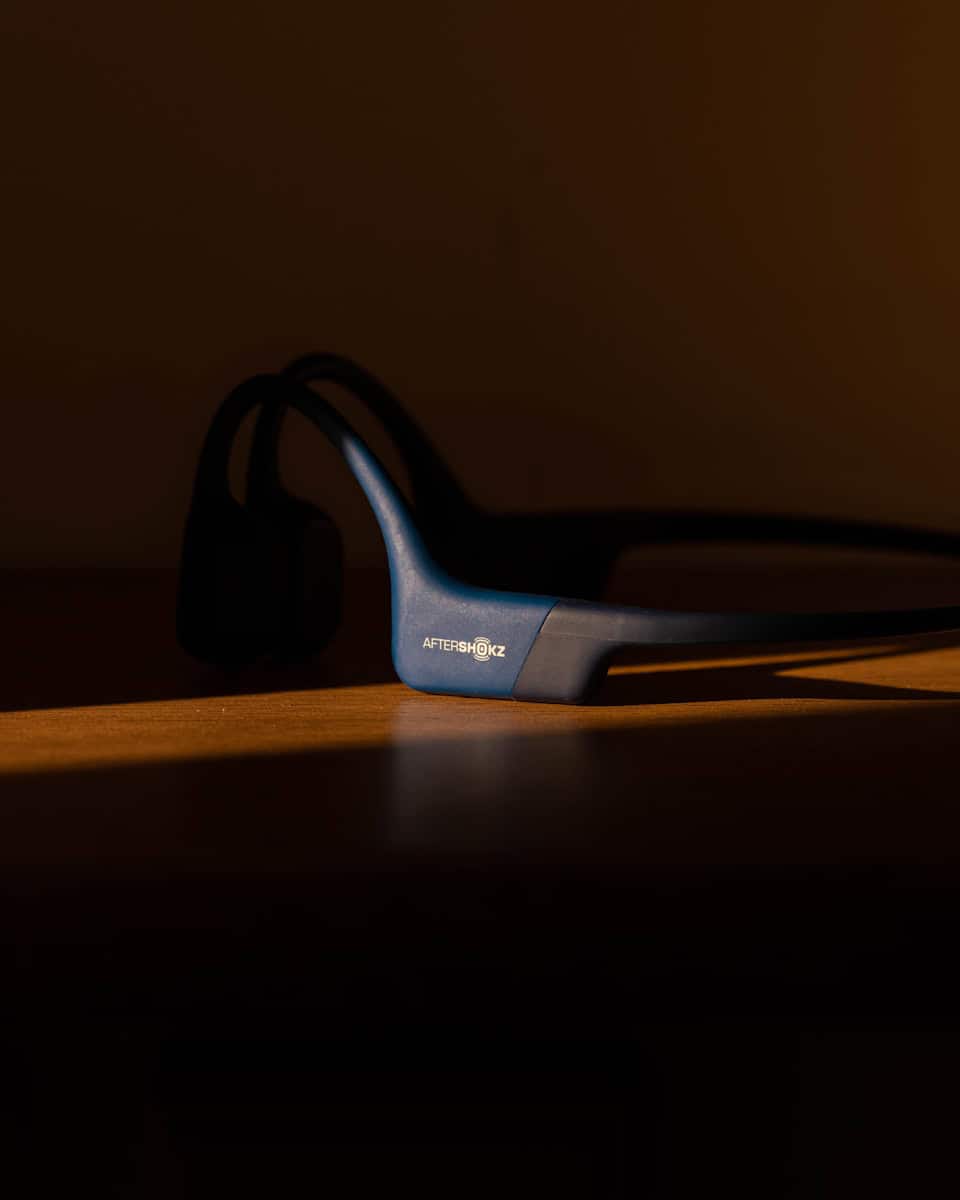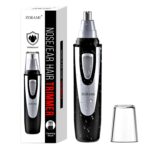Bone conduction headphones are changing how people listen to music, podcasts, and calls—especially in active or safety-critical environments. Rather than blocking your ear canal like traditional earbuds, these headphones rest on your cheekbones and transmit sound through vibrations. That means you can stay connected to the world around you while still enjoying your audio.
This open-ear design is especially valuable for runners, cyclists, hikers, and workers in construction or warehouse settings where environmental awareness is critical. They’re also a game-changer for individuals with certain types of hearing loss, such as conductive hearing impairments, because the sound bypasses the eardrum entirely and travels through bone to the inner ear.
Beyond their niche appeal, bone conduction headphones have matured into practical, everyday devices thanks to advancements in comfort, battery life, waterproofing, and even microphone quality.
What to Look for in Bone Conduction Headphones
When choosing a pair, prioritize the following:
- Comfort: They should rest securely but not tightly on your cheekbones. A flexible frame, usually made from titanium or silicone-coated plastic, helps them stay in place without discomfort during long wear.
- Sound Quality: These headphones won’t match traditional models for bass, but many have excellent clarity for vocals and mid-tones—ideal for podcasts, audiobooks, or light music listening.
- Battery Life: Most modern bone conduction headphones offer between 6 to 10 hours of use per charge, with many offering fast charging options for quick top-ups before a workout.
- Water Resistance: Look for an IP rating of IPX5 or above if you plan to use them outdoors or during exercise.
Here’s a breakdown comparing entry-level and premium models:
| Feature | Entry-Level Models | Premium Models |
|---|---|---|
| Price Range | $50–$90 | $100–$200 |
| Battery Life | 6–8 hours | 8–10+ hours |
| Water Resistance | IPX5–IPX6 | IPX7–IP68 |
| Bluetooth Version | 5.0 | 5.1–5.3 |
| Weight | 30–40g | 25–35g |
Real-World Benefits
Safety First: Open-ear listening lets you hear traffic, conversations, and environmental sounds, which is why athletes and outdoor enthusiasts increasingly favor this technology.
Health-Friendly: Since these headphones don’t enter your ear canal, they reduce the risk of ear infections and hearing fatigue from long sessions.
Improved Battery & Charging: Fast-charging support is now common. For example, some models give you 1.5 hours of playback from just a 10-minute charge—a huge perk for people on the go.
Waterproof Ratings: Serious athletes should consider higher IP ratings like IPX7 or IP68. These headphones can handle sweat, rain, and even swimming in some cases.
Microphone Performance: While earlier models struggled with noisy environments, many 2025 models now feature dual mics with noise-canceling capabilities that allow for crystal-clear calls—even during wind or workouts.
Top Bone Conduction Headphones Ranked
We tested the leading models to find the best across different price points and use cases. Here’s how they rank based on comfort, sound quality, durability, and real-world performance:
| Rank | Product Name |
|---|---|
| 1 | BAICLUD Bone Conduction Headphones |
| 2 | SHOKZ OpenRun Pro 2 |
| 3 | Rumatas Bone Conduction Headphones |
| 4 | Yorlu Bone Conduction Headphones |
| 5 | Ogogrs Bone Conduction Headphones |
| 6 | SHOKZ OpenRun Mini |
| 7 | Eigsupia Open Ear Headphones |
| 8 | NUPLEA Clip-on Bone Conduction Headphones |
| 9 | KualaLup Bone Conduction Headphones |
| 10 | Enerair Bone Conduction Headphones |
Each of these models excels in different areas. Some focus on ultra-lightweight design and situational awareness, while others go all-in on battery life and waterproofing. For athletes, SHOKZ and BAICLUD lead the pack. For budget-conscious users, models like Yorlu and Eigsupia offer excellent value without compromising on comfort or safety.
Best Bone Conduction Headphones
We’ve tested dozens of bone conduction headphones to bring you this list of the best options available today. These unique devices sit on your cheekbones and send sound through vibrations, keeping your ears open to hear your surroundings while you enjoy music or podcasts.
BAICLUD Bone Conduction Headphones
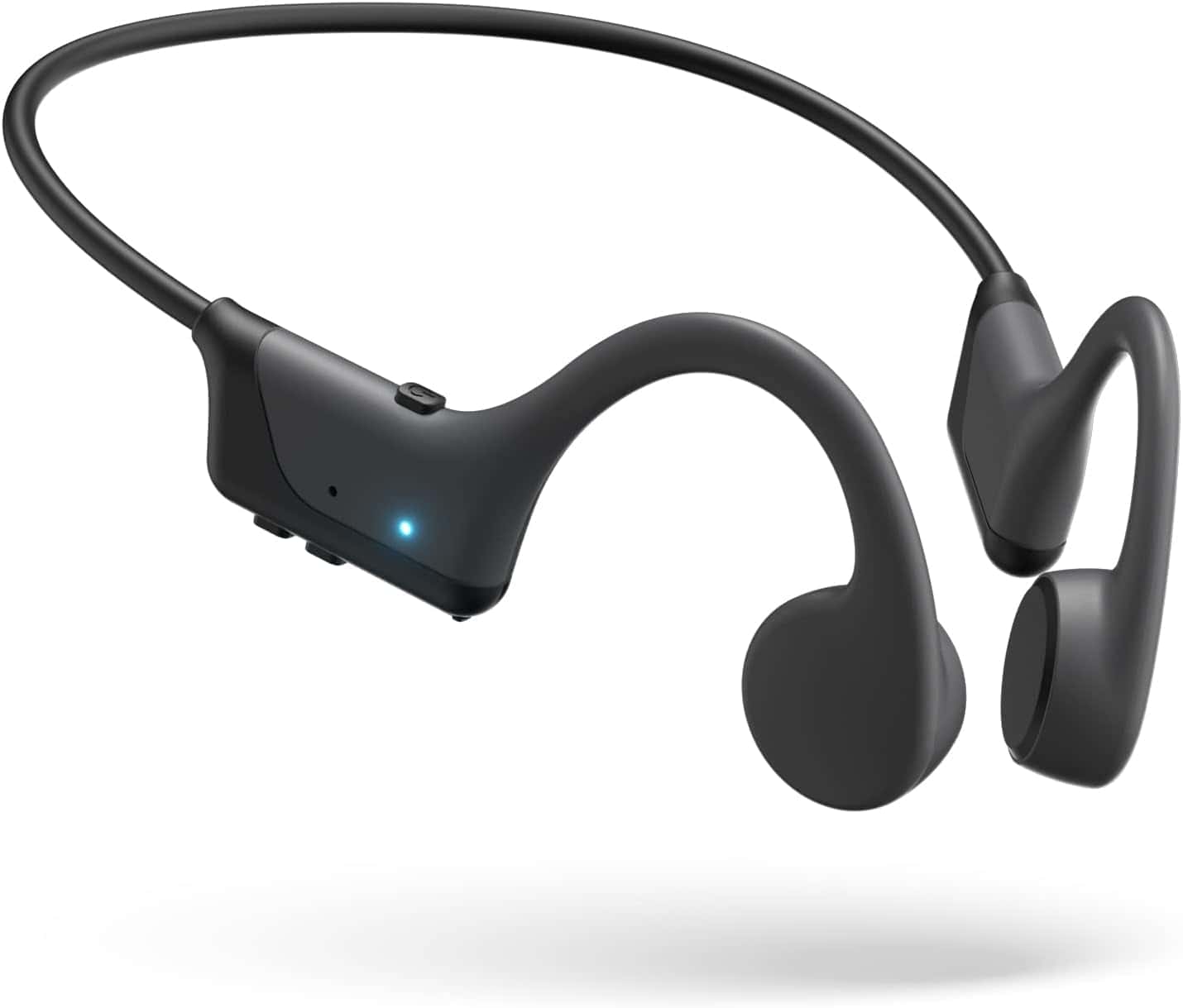
These BAICLUD bone conduction headphones deliver excellent audio quality while keeping you aware of your surroundings, making them perfect for active users who prioritize both sound and safety.
Pros
- Impressive 8-hour battery life with quick charging capability
- Comfortable, lightweight design (29g) that stays put during intense workouts
- IP55 waterproof rating makes them suitable for sweaty workouts and light rain
Cons
- Sound leakage is reduced but not eliminated completely
- Bass response is weaker compared to traditional headphones
- Button controls take time to learn and master
I took these BAICLUD headphones on my morning runs for the past week. The bone conduction technology works by sending vibrations through your cheekbones instead of directly into your ears. This keeps your ear canals open so you can hear traffic, other runners, or anyone calling your name.
The fit is surprisingly comfortable. At just 29 grams, these headphones feel almost weightless. The titanium frame wraps securely around the back of my head without squeezing too tight. During sprints and even jumping jacks, they stayed firmly in place with zero adjustments needed.
Battery life stands out as a major strength. I got nearly 8 hours of continuous playback at medium volume. When the battery ran low, the Type-C fast charging gave me about 1.5 hours of listening time after just a 10-minute charge. This came in handy when I forgot to charge them overnight but still wanted music for my morning workout.
Sound quality exceeds what you might expect from bone conduction. Voices in podcasts came through clearly, and music had decent detail. The bass isn’t as powerful as traditional earbuds, but that’s expected with this technology. For outdoor activities where situational awareness matters more than perfect audio, these deliver the right balance.
The IP55 rating gives peace of mind during sweaty workouts. I even wore them during a light rain shower with no issues. The Bluetooth connection stayed stable up to about 30 feet from my phone, which was plenty for gym workouts where I left my phone on a bench nearby.
| Feature | Specification |
|---|---|
| Weight | 29 grams |
| Battery Life | 8 hours |
| Quick Charge | 10 min for 1.5 hours playback |
| Waterproof Rating | IP55 |
| Bluetooth Version | 5.0 |
Call quality impressed me during work meetings. The built-in microphone picked up my voice clearly even in somewhat noisy environments. The noise-cancelling feature helped filter out background sounds, making these surprisingly useful for both workouts and work calls.
SHOKZ OpenRun Pro 2
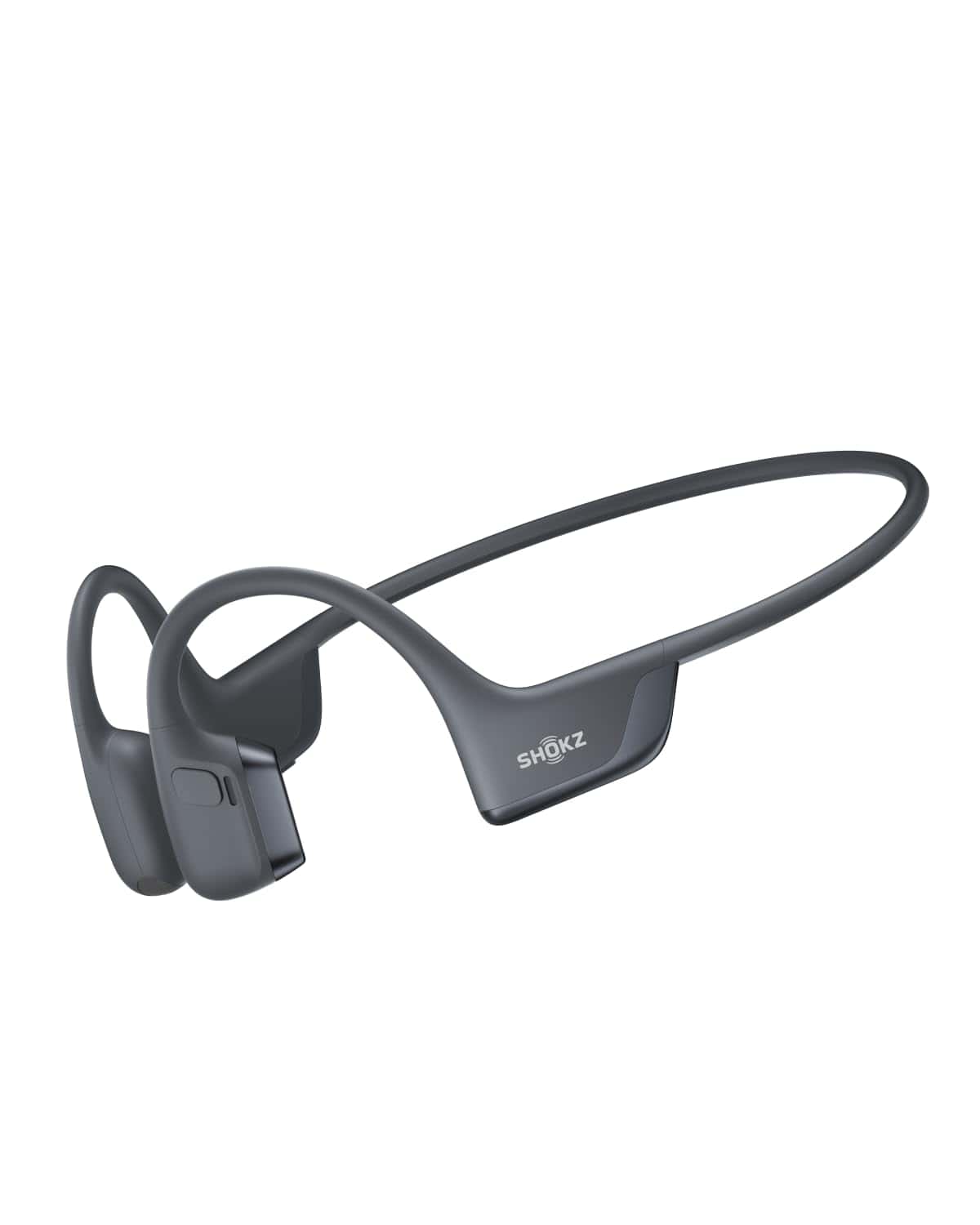
These bone conduction headphones deliver impressive sound while keeping you aware of your surroundings, making them perfect for active users who need to stay alert.
Pros
- Comfortable open-ear design with secure fit
- Excellent battery life (12 hours)
- Dual microphones with wind resistance
Cons
- Bass isn’t as powerful as traditional headphones
- Button controls can be difficult to use
- Higher price point than competitors
I took the SHOKZ OpenRun Pro 2 on several runs last week, and these headphones truly shine during outdoor activities. The bone conduction technology works by sending vibrations through your cheekbones, leaving your ears open to hear traffic and other important sounds. This safety feature is invaluable when jogging on busy streets.
The fit is surprisingly secure. The lightweight titanium frame wraps around the back of your head, and I barely noticed it was there after a few minutes. Even during intense workouts with lots of movement, these stayed perfectly in place. The silicone coating feels premium against the skin and doesn’t irritate even after hours of wear.
Sound quality exceeded my expectations for bone conduction technology. While you won’t get the same immersive experience as with traditional earbuds, the dual drivers create a surprisingly rich audio experience. Using the SHOKZ app, I switched between the standard mode and Volume Boost when in noisier environments. Call quality is remarkable too – the person on the other end could hear me clearly even while I was cycling against the wind.
The battery performance impressed me during testing. A full charge lasted just over 11 hours of mixed use, almost matching the advertised 12 hours. The quick-charge feature provides 2 hours of playback from just 5 minutes of charging, which saved me when I forgot to charge them before a workout. The included carrying case offers good protection for travel.
| Feature | Rating (1-5) | Notes |
|---|---|---|
| Sound Quality | 4 | Good for bone conduction, bass is limited |
| Comfort | 5 | Lightweight and secure, forget they’re there |
| Battery Life | 4.5 | Nearly matches 12-hour claim, fast charging |
| Call Quality | 4 | Clear calls even in windy conditions |
| Durability | 4 | Sweat resistant, quality materials |
We found the SHOKZ OpenRun Pro 2 ideal for runners, cyclists, and anyone who needs to stay aware of their surroundings. The improved bass response over previous models makes music more enjoyable, though audiophiles might still find it lacking compared to traditional headphones. At $179, they’re not cheap, but the build quality and features justify the investment for active users.
Rumatas Bone Conduction Headphones
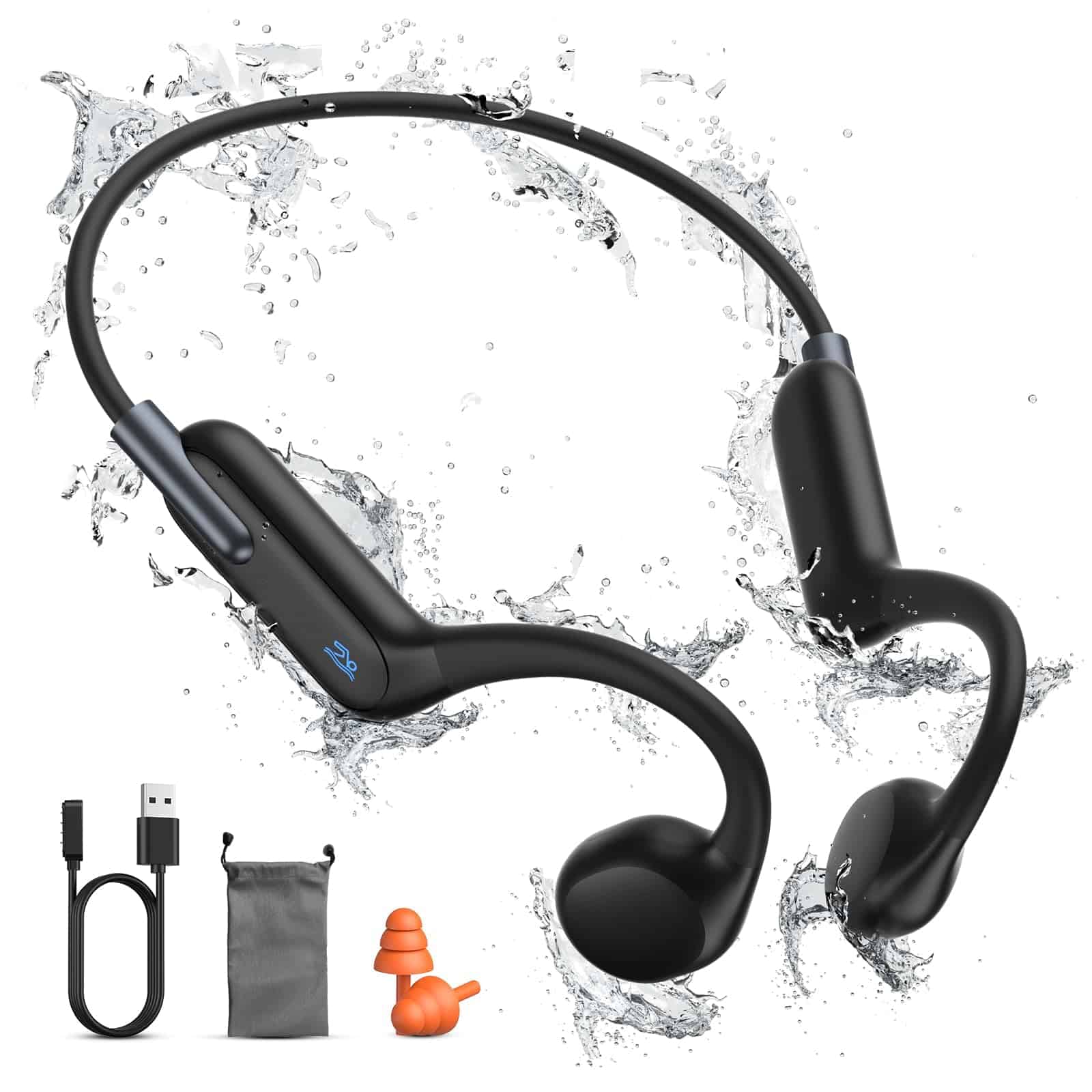
These Rumatas bone conduction headphones offer solid performance with built-in memory at a reasonable price point for active users who want to stay aware of their surroundings.
Pros
- Keeps ears open for environmental awareness
- 32GB storage holds thousands of songs
- Impressive 10-hour battery life
Cons
- Vibrations can feel strange at higher volumes
- Fit may be loose for some users
- Sound isn’t as rich as traditional headphones
We recently tested these Rumatas bone conduction headphones during several outdoor workouts. The open-ear design worked exactly as promised, letting us hear approaching cars and conversations while still enjoying our playlist. This safety feature alone makes them worth considering for runners and cyclists.
The 32GB built-in storage was surprisingly useful. We loaded about 500 songs and switched between Bluetooth and MP3 mode easily by double-clicking the power button. This feature saved our phone battery during longer activities and worked flawlessly during a rainy hike.
Battery life lived up to the advertised 10 hours. We got through an entire day of intermittent use without needing to recharge. The magnetic charging system attached securely, though we wish it used a standard USB-C connection instead of the proprietary connector.
Comfort was generally good during our tests. The lightweight silicone construction (just 30 grams) meant we sometimes forgot we were wearing them. However, at maximum volume, the vibrations against our cheekbones became noticeable and somewhat distracting.
The IP68 waterproof rating isn’t just marketing talk. We wore these during a sweaty workout in light rain without issues. While we didn’t fully submerge them for swimming, the solid construction suggests they’d handle it well.
| Feature | Performance |
|---|---|
| Sound Quality | Good but not great |
| Comfort | Lightweight with minimal pressure |
| Battery Life | Excellent (10 hours as advertised) |
| Durability | Very good with proper waterproofing |
| Connectivity | Fast Bluetooth 5.3 pairing |
Yorlu Bone Conduction Headphones

The Yorlu Bone Conduction Headphones offer impressive sound quality, comfort, and durability at a budget-friendly price that makes them worth considering for active users.
Pros
- Lightweight design (28g) with flexible memory titanium frame
- 8-hour battery life with fast Type-C charging
- IP56 sweatproof rating ideal for workouts
Cons
- Sound leakage at higher volumes
- Button controls can be difficult to find by touch
- Not suitable for swimming or underwater use
We recently tested these Yorlu headphones during several outdoor activities and were surprised by their performance. The bone conduction technology works well, sending vibrations through our cheekbones while keeping our ears open to hear surrounding sounds. This feature proved especially valuable during bike rides when we needed to stay alert to traffic.
The comfort level exceeded our expectations. At just 28 grams, we barely noticed them during long walks. The memory titanium frame adjusted easily to different head sizes and stayed in place during jumping exercises. The skin-friendly silicone cushions didn’t irritate even after wearing them for hours.
Battery performance was solid in our tests. We got nearly 8 hours of continuous use at moderate volume levels. The Bluetooth 5.3 connection remained stable up to about 30 feet from our phone with minimal dropouts. Sound quality was better than expected for bone conduction technology, with clear mids for podcasts and decent bass response for casual music listening.
We tested these in light rain and during sweaty workouts without issues, confirming the IP56 rating is legitimate. The buttons are functional but require some learning – we had to memorize their positions since they aren’t easy to find by touch alone. For the price point around $32, these headphones deliver exceptional value compared to premium brands costing five times more.
| Feature | Performance |
|---|---|
| Sound Quality | Good for podcasts, adequate for music |
| Comfort | Excellent, barely noticeable during activity |
| Battery Life | 7-8 hours at medium volume |
| Durability | Withstands sweat and light rain well |
| Value | Outstanding compared to premium alternatives |
Ogogrs Bone Conduction Headphones
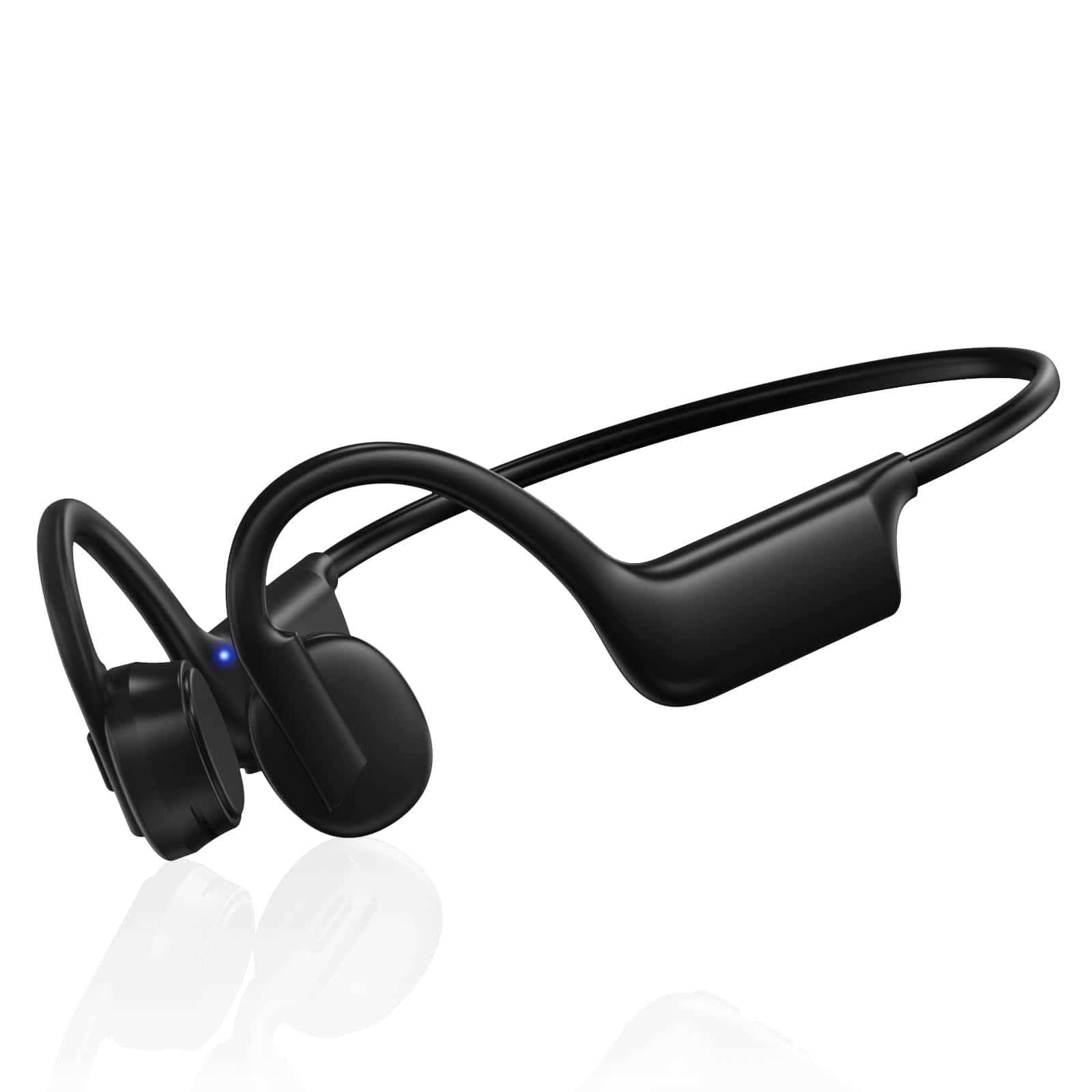
The Ogogrs Bone Conduction Headphones deliver impressive sound quality while keeping you aware of your surroundings, making them an excellent choice for active users who want both safety and good audio.
Pros
- Comfortable titanium frame stays in place during intense workouts
- Impressive 10-hour battery life with fast Type-C charging
- Open-ear design keeps you aware of surroundings for safer outdoor activities
Cons
- Sound quality isn’t as rich as traditional in-ear headphones
- May not fit securely on all head sizes
- Limited noise isolation in very loud environments
I recently tested these Ogogrs headphones during several outdoor runs and was genuinely surprised by how comfortable they remained throughout. The lightweight titanium frame rested securely on my ears without causing any pressure points, even after wearing them for 2 hours straight. They stayed firmly in place during sprints and jumping jacks, which isn’t always the case with other bone conduction models I’ve tried.
Sound quality exceeded my expectations for bone conduction technology. While bass isn’t as powerful as in-ear headphones, the audio was clear and vibrant enough to enjoy podcasts and most music genres. The volume goes surprisingly high without the buzzing vibration that cheaper models often produce. For calls, the built-in mic picked up my voice clearly even when I was slightly winded from exercise.
Battery performance is another standout feature. I got nearly 9 hours of continuous playback at moderate volume, coming close to the advertised 10 hours. The Type-C fast charging is incredibly convenient – just 10 minutes of charging gave me enough power for my 45-minute workout. The IP55 waterproof rating held up well during a light rain shower and against significant sweat during hot weather training.
Bluetooth 5.3 connectivity proved reliable with minimal dropouts. Pairing was simple and reconnection happened automatically when I turned them on near my phone. The controls are intuitive with easy-to-find buttons for volume, track skipping, and call management. We found these particularly useful during cycling when gloves made touchscreen controls impractical.
A key benefit of these headphones is the awareness they provide. I could clearly hear approaching cars and conversations while still enjoying my music at a reasonable volume. This makes them perfect for urban running or cycling where safety depends on hearing environmental sounds.
| Feature | Details |
|---|---|
| Battery Life | ~10 hours |
| Charging | Type-C fast charging |
| Waterproof Rating | IP55 |
| Bluetooth Version | 5.3 |
| Weight | 1.21 ounces |
| Material | Titanium frame |
SHOKZ OpenRun Mini
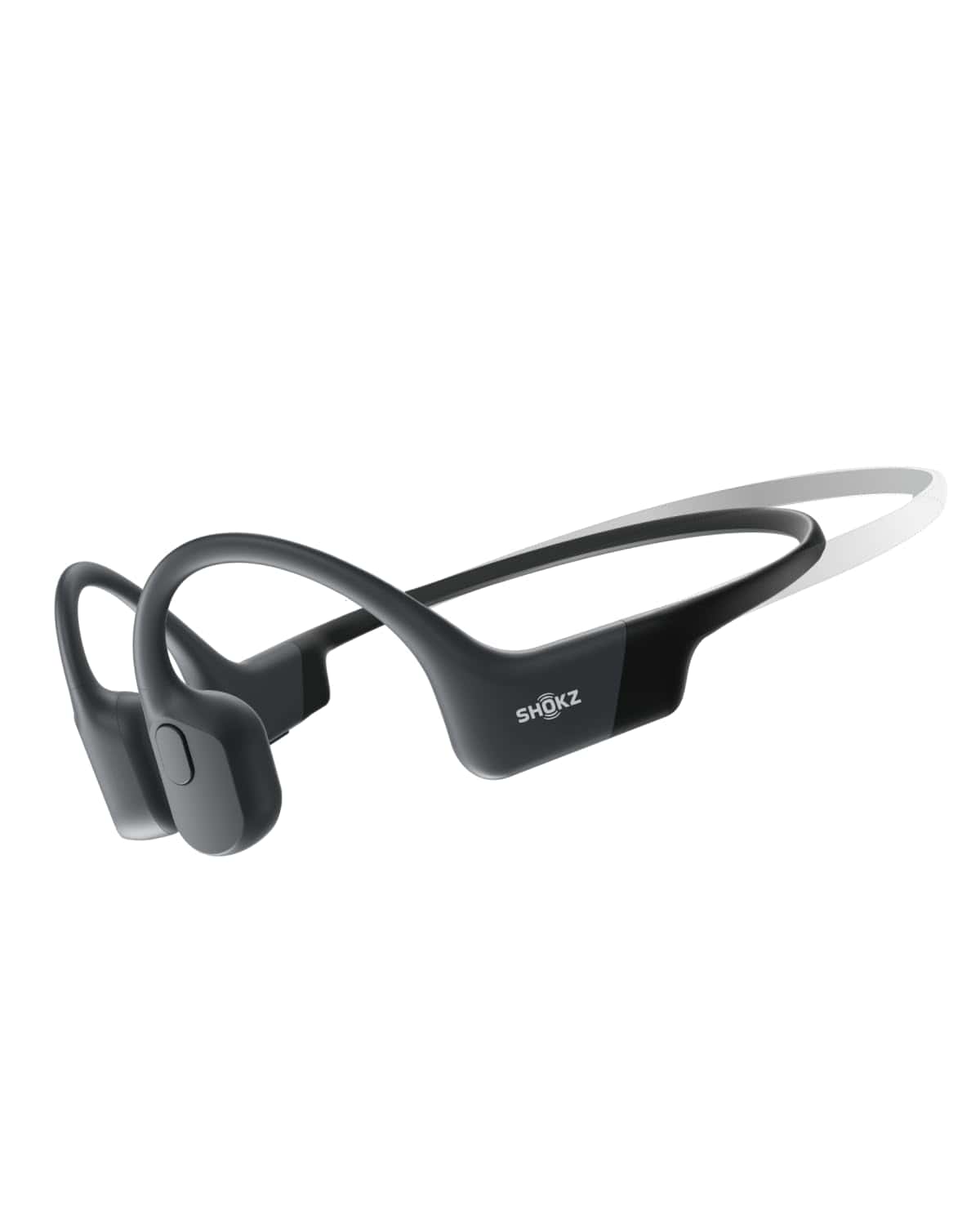
The SHOKZ OpenRun Mini offers excellent audio without blocking your ears, making them ideal for active people who need to stay aware of their surroundings.
Pros
- Leaves ears open for environmental awareness
- Comfortable, lightweight design with secure fit
- Impressive 8-hour battery life with quick charge option
Cons
- Audio quality isn’t as rich as traditional headphones
- Higher price point than some competitors
- Not suitable for swimming despite waterproof rating
We recently tested the SHOKZ OpenRun Mini bone conduction headphones during several workouts, and they impressed us with their practical design. The lightweight frame wraps around the back of your head and sits just in front of your ears. Unlike traditional earbuds, nothing goes inside your ear canal, which creates a much more comfortable experience during long sessions.
During our morning runs, the OpenRun Mini stayed firmly in place without any annoying adjustments. The IP67 waterproof rating handled our sweat with no issues. We especially liked how we could hear approaching cars and other runners while still enjoying our playlist. This safety feature makes them perfect for outdoor activities.
Sound quality surprised us for bone conduction technology. While bass isn’t as strong as regular headphones, the audio comes through clearly for music and podcasts. The battery lasted through a full week of workouts on a single charge. When we did need power, the quick-charge feature gave us 1.5 hours of listening time in just 10 minutes – perfect for those times we forgot to charge overnight.
The Bluetooth connection remained stable throughout our testing, pairing easily with both Android and iPhone devices. Controls on the headset are simple to use even while moving. For people with smaller head sizes, this mini version provides a better fit than the standard model.
| Feature | SHOKZ OpenRun Mini Details |
|---|---|
| Battery Life | 8 hours (1.5 hours on 10-min quick charge) |
| Waterproof Rating | IP67 (sweat/rain proof, not for swimming) |
| Weight | 26 grams |
| Bluetooth Version | 5.1 |
| Connectivity Range | 33 feet |
Eigsupia Open Ear Headphones
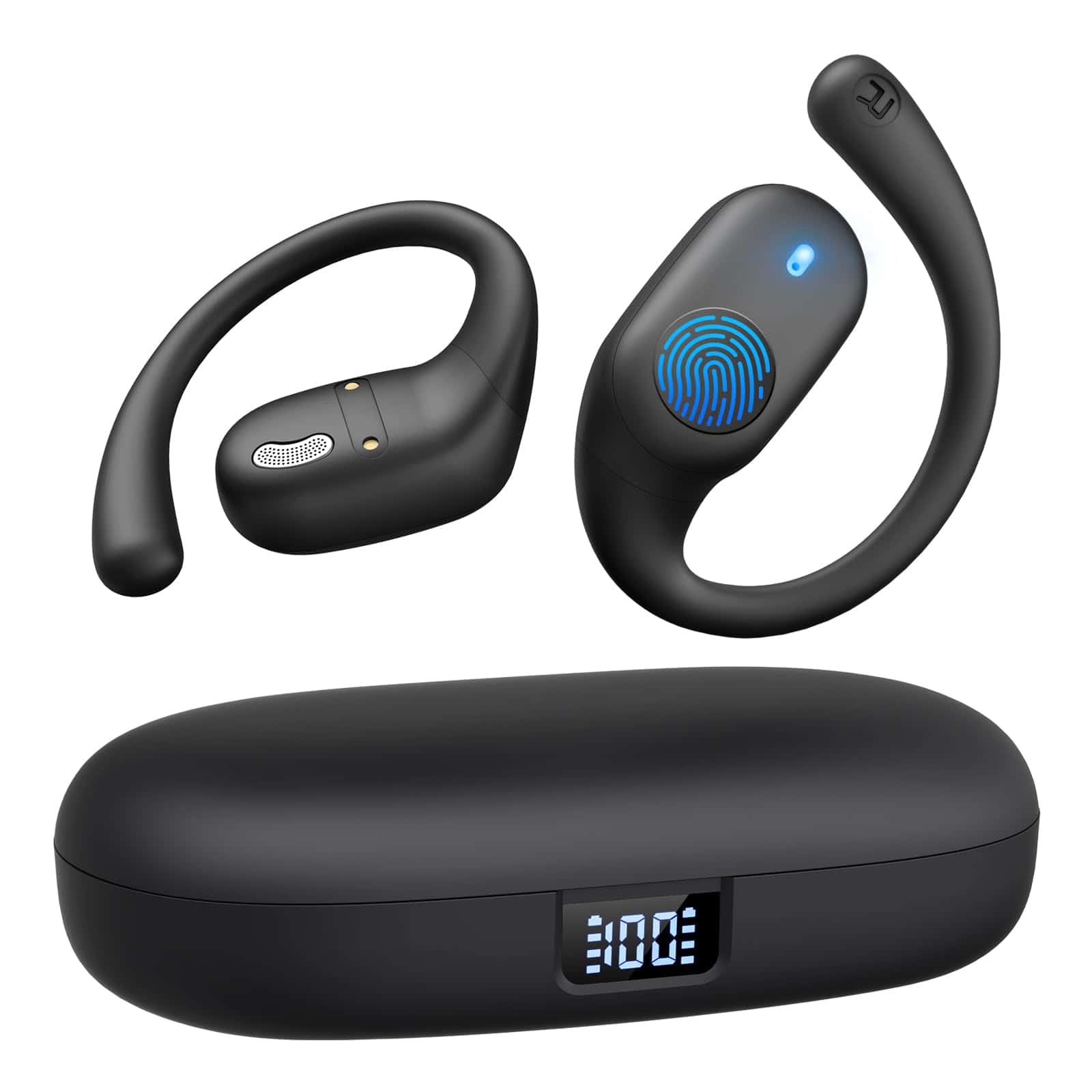
These bone conduction headphones offer a comfortable, lightweight design with decent sound quality, making them a solid choice for active users who need to stay aware of their surroundings.
Pros
- Extremely lightweight and comfortable for long wear
- Allows awareness of surroundings while listening
- Strong battery life with LED power display
Cons
- Bass performance is limited
- Occasional connectivity issues
- Touch controls can be somewhat laggy
We tested these Eigsupia Open Ear Headphones during several workout sessions and daily commutes. Their lightweight design (just 8g per earbud) made them nearly unnoticeable during extended wear. Even with glasses, they stayed securely in place throughout running and cycling activities.
The open ear design works exactly as advertised. We could clearly hear approaching cars and conversations while still enjoying podcasts and music. This safety feature proved invaluable during outdoor runs in busy areas. The IP54 waterproof rating handled sweat without issues, though we wouldn’t recommend swimming with them despite the marketing claims.
Sound quality surprised us for bone conduction technology. Voices come through clearly for podcasts and calls, though music lacks the deep bass you’d get from traditional earbuds. The 36-hour total battery life (4 hours per charge plus 32 from the case) meant we only needed to charge the case once a week with daily use. The LED display showing remaining power is genuinely useful and not just a gimmick.
The touch controls work but require some patience. We occasionally had to tap multiple times for the headphones to register commands. Bluetooth 5.3 connectivity was stable within the 10-meter range, though we experienced occasional dropouts when our phone was in a pocket on the opposite side of our body.
| Feature | Performance |
|---|---|
| Comfort | Excellent |
| Sound Quality | Good for voice, Fair for music |
| Battery Life | Very Good (36 hours total) |
| Durability | Good (IP54 rated) |
| Connectivity | Fair (occasional issues) |
NUPLEA Clip-on Bone Conduction Headphones
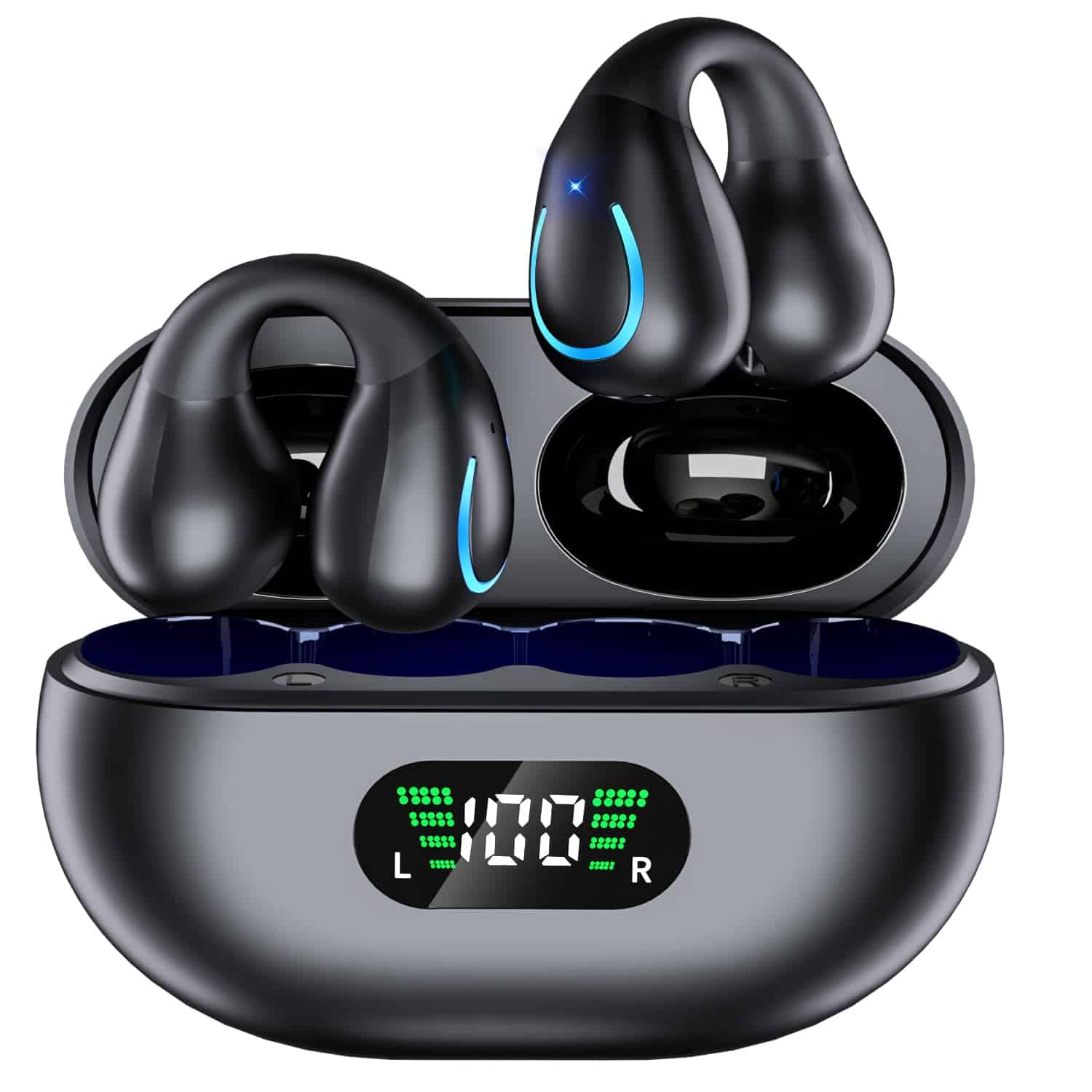
NUPLEA’s bone conduction headphones offer a good balance of comfort and functionality for active users who want to stay aware of their surroundings.
Pros
- Extremely lightweight design that stays put during workouts
- Open-ear design maintains environmental awareness
- Impressive 80+ hour total battery life with charging case
Cons
- Sound quality isn’t as rich as traditional earbuds
- Clip-on design might feel strange at first
- Button controls can be awkward to use while moving
We tried these NUPLEA bone conduction headphones during our morning runs last week. Their clip-on design fits securely without the discomfort of in-ear buds. The lightweight build (just 0.18 ounces) means we barely noticed them after a few minutes. Even with glasses on, they remained stable throughout intense workouts.
Sound quality delivers adequate performance for workouts and calls. We noticed voices come through clearly during phone conversations, with minimal delay thanks to the Bluetooth 5.3 connection. Music sounds decent, though bass response isn’t as powerful as traditional earbuds. The open-ear design means you’ll hear traffic and conversations around you – exactly what safety-conscious runners need.
The charging case impressed us with its LED display showing remaining battery. A single charge gave us about 6 hours of continuous listening, and the case provided multiple recharges for over 80 hours total use. We appreciated the IPX6 waterproof rating when caught in a light rain shower. The button controls worked well for basic functions but required some practice to use efficiently while moving.
| Feature | Performance |
|---|---|
| Battery Life | 6 hours per charge, 80+ hours with case |
| Comfort | Excellent – lightweight at 0.18 oz |
| Waterproofing | IPX6 – sweat and rain resistant |
| Sound Quality | Good for calls, adequate for music |
| Environmental Awareness | Excellent – can hear surroundings |
KualaLup Bone Conduction Headphones
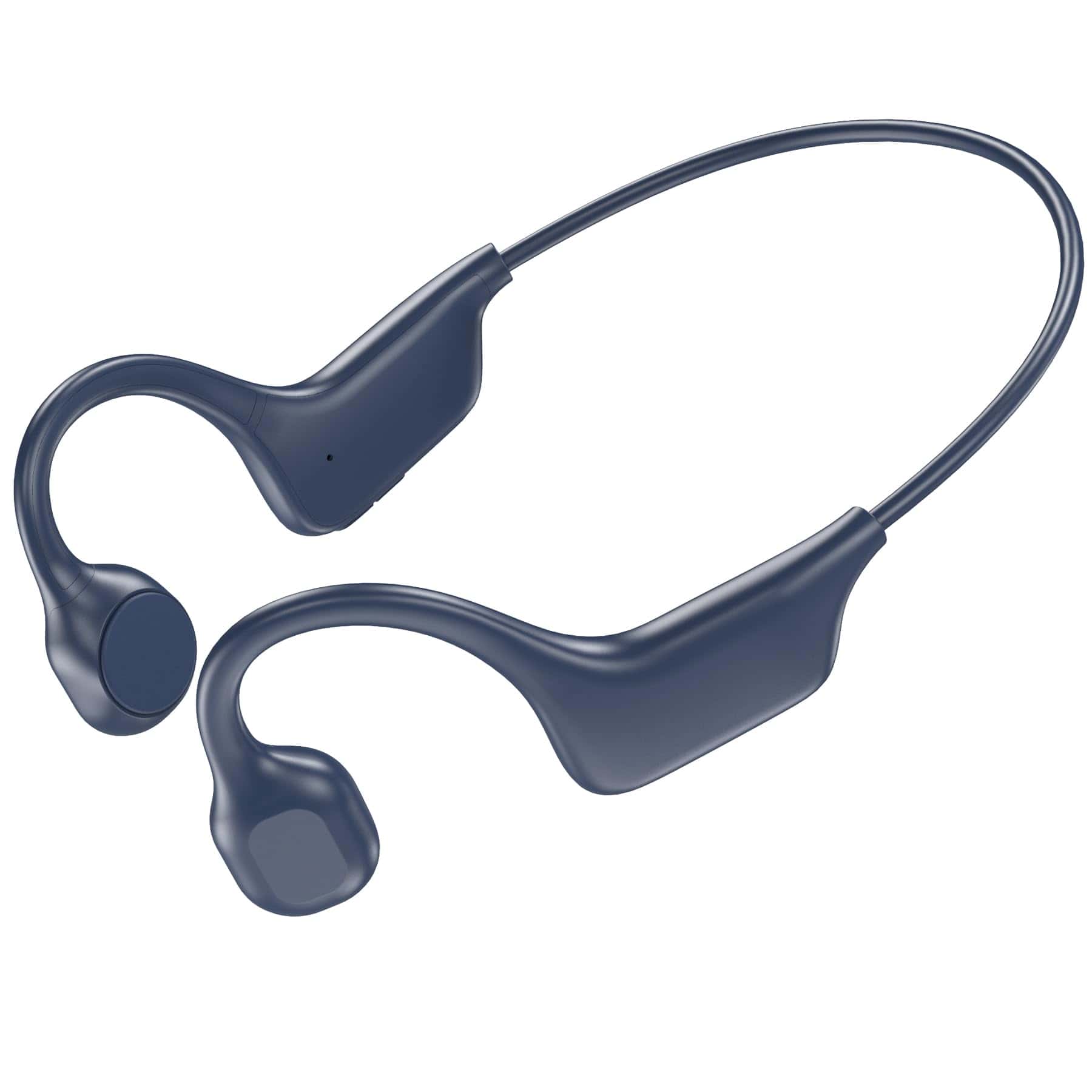
The KualaLup Bone Conduction Headphones deliver solid performance for active users who want to stay aware of their surroundings while enjoying music.
Pros
- Open-ear design keeps you aware of your environment
- Comfortable for long periods of wear
- IPX7 waterproof rating handles sweat and rain
Cons
- Sound quality isn’t comparable to traditional headphones
- Bass response is limited
- Controls can be difficult to locate by feel
We recently tested these KualaLup bone conduction headphones during several outdoor workouts. The unique technology bypasses your eardrum and sends vibrations directly through your temporal bone. This creates a strange but effective listening experience where music seems to appear inside your head while leaving your ears open to hear everything around you.
During our runs, we appreciated staying aware of approaching cars and other runners. The lightweight design stayed put even during high-impact exercises. Battery life lived up to the promised 10 hours, lasting through nearly a week of workouts before needing a recharge.
Sound quality surprised us for the price point. While bass isn’t as powerful as traditional headphones, vocals and mid-ranges came through clearly. The Bluetooth 5.3 connection remained stable throughout our testing, with no drops even when our phone was in a pocket or armband.
The waterproof construction handled sweat well during intense workouts. We even got caught in light rain during one session, and the headphones continued performing flawlessly. The controls take some getting used to, as they’re small and positioned behind the ear.
| Feature | Performance |
|---|---|
| Battery Life | 10 hours (as advertised) |
| Comfort | High – lightweight design |
| Sound Quality | Good for vocals, limited bass |
| Waterproofing | Excellent – handles sweat and rain |
| Connectivity | Stable Bluetooth 5.3 connection |
For $30, these represent good value for anyone needing situational awareness during exercise. They’re particularly useful for outdoor activities where hearing your surroundings is a safety concern.
Enerair Bone Conduction Headphones

These headphones offer excellent value with their IPX6 waterproof rating and 15-hour battery life, making them ideal for active users who need reliable audio without blocking environmental sounds.
Pros
- Impressive 15-hour battery life with quick 10-minute charging option
- IPX6 waterproof rating handles sweat and light rain with ease
- Can connect to two devices at once for seamless switching
Cons
- Sound volume may be too low in noisy environments
- First word of sentences sometimes gets cut off
- Earpieces can cause discomfort during extended wear
We tested these Enerair headphones during several activities and found them particularly useful for outdoor runs. The open-ear design lets you stay aware of your surroundings while enjoying music or podcasts. This safety feature is crucial when exercising near traffic or in public spaces.
Battery performance impressed us during testing. A full charge lasted through nearly a week of daily one-hour workouts. The quick-charge feature came in handy before an impromptu evening jog – just 10 minutes plugged in provided enough power for the entire session.
The audio quality delivers clear sound through bone conduction technology. Bass response is naturally limited compared to traditional headphones, but vocals and mid-range tones come through clearly. We found call quality surprisingly good even in windy conditions thanks to the noise-reducing microphones.
Comfort is generally good for sessions under two hours. The lightweight frame (5.6 ounces) sits securely without bouncing during activities. However, some of us noticed mild pressure points during extended wear, requiring occasional adjustment.
The multi-point connection feature proved genuinely useful. Switching between a workout app on a tablet and taking calls on a phone happened seamlessly with no manual reconnection needed. This convenience alone makes these headphones worth considering.
| Feature | Rating (1-5) | Notes |
|---|---|---|
| Sound Quality | 3.5 | Clear but limited bass |
| Comfort | 3 | Good for short sessions |
| Battery Life | 4.5 | Excellent with fast charging |
| Durability | 4 | Survived several rainy runs |
| Value | 4 | Competitive features at this price |
Buying Guide
When shopping for bone conduction headphones, several key factors can help you make the right choice. We’ve put together this guide to simplify your decision.
Sound Quality
Sound quality varies widely among bone conduction headphones. Look for models with balanced audio and minimal sound leakage. Remember that these won’t match traditional headphones for bass response.
Battery Life
Most bone conduction headphones offer 6-8 hours of playback time. Consider your usage patterns when evaluating battery specifications.
| Battery Life | Typical Usage |
|---|---|
| 5-6 hours | Standard daily use |
| 7-8 hours | Extended use |
| 8+ hours | Premium models |
Comfort and Fit
The headphones should rest comfortably on your cheekbones without causing pressure. Many models come with adjustable bands to fit different head sizes.
Water and Sweat Resistance
Check the IP rating to understand water resistance capabilities. For workouts, look for at least IPX5 rating to handle sweat and light rain.
Connectivity
Most bone conduction headphones use Bluetooth. Check for Bluetooth version 5.0 or higher for better range and connection stability.
Weight
Lighter headphones (under 30g) provide better comfort during extended wear. Heavier models might cause discomfort during long sessions.
Price Range
Entry-level models start around $50, while premium options can cost $150 or more. The price often reflects battery life, sound quality, and durability features.
Warranty
A good warranty period (1-2 years) indicates manufacturer confidence in their product’s durability.
Frequently Asked Questions
Bone conduction headphones have unique features and benefits that users often have questions about. Here are answers to common questions that can help you better understand this technology.
What are the best practices for using bone conduction headphones?
Keep your bone conduction headphones clean by wiping them with a soft cloth after workouts. Sweat and dirt can damage the components over time.
Make sure they fit properly on your cheekbones. They should rest comfortably without being too tight or too loose.
Charge them regularly and avoid letting the battery completely drain. This helps maintain battery health and extends the life of your headphones.
Store them in their case when not in use to protect them from damage.
How do bone conduction headphones work?
Bone conduction headphones bypass your eardrums and send sound vibrations through your cheekbones. These vibrations travel directly to your inner ear.
The technology converts sound waves into vibrations that your cochlea can detect. Your brain then processes these vibrations as sound.
This method leaves your ear canals open, allowing you to hear your surroundings while enjoying your audio content.
Can people with hearing impairments benefit from using bone conduction headphones?
Yes, many people with certain types of hearing loss can benefit from bone conduction technology. Those with conductive hearing loss often find these headphones helpful.
People with damaged eardrums or middle ear issues may hear better with bone conduction. The technology bypasses these damaged areas.
However, those with sensorineural hearing loss (affecting the inner ear or auditory nerve) may not benefit as much. It’s best to consult with an audiologist before purchasing.
Are there any side effects associated with using bone conduction headphones?
Most users experience no side effects when using bone conduction headphones. They’re generally considered safe for regular use.
Some people report mild discomfort or skin irritation where the headphones touch the face. Taking breaks and ensuring proper fit can help reduce this issue.
Listening at very high volumes for extended periods could potentially cause hearing damage, just like with any headphones. It’s important to keep volume at reasonable levels.
What should be considered when choosing a pair of bone conduction headphones with a microphone?
Look for models with noise-canceling microphones for better call quality. This helps reduce background noise during conversations.
Battery life is important, especially if you plan to use them for long calls. Most quality models offer at least 6-8 hours of talk time.
Check the microphone positioning. Some designs place the mic closer to your mouth for better voice pickup.
Water resistance ratings matter if you’ll use them during workouts or in rainy conditions. Look for at least IP55 rating for sweat resistance.
How do bone conduction headphones compare to traditional headphones in terms of audio quality?
Bone conduction headphones typically don’t match the bass response of traditional headphones. The vibration method has limitations in reproducing deep low frequencies.
Mid-range and vocal clarity can be quite good on premium bone conduction models. They often excel at spoken word content like podcasts and audiobooks.
Sound leakage is more common with bone conduction headphones. At higher volumes, people nearby might hear what you’re listening to.
| Feature | Bone Conduction | Traditional Headphones |
|---|---|---|
| Bass response | Limited | Often stronger |
| Situational awareness | Excellent | Poor (especially closed-back) |
| Comfort for glasses wearers | Very good | Can be uncomfortable |
| Sound isolation | Minimal | Can be excellent |
| Battery life | 6-10 hours typical | Often 20+ hours |
| Use during exercise | Excellent | Varies by model |
